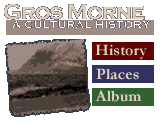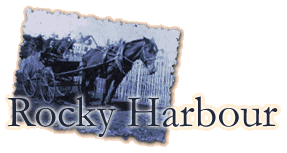
 |
Annual parade of Orange Lodge
and L.O.B.A 1945 |
| Plane crash in
the harbour 1946 |
 |
 |
Local soldiers head off to
World War II 1917 |
 |
Reverend Gill in horse
and buggy 1931 |
| Lobster Cove
Head Lighthouse 1914 |
 |
 |
Where the Potomac went aground 1914
|
| The Young family
with car 1935 |
 |
 |
The Young children feeding
chickens 1944 |

Rocky Harbour was and still is a fishing community. It is also the headquarters for Gros Morne National Park. Rocky Harbour got its name from the rocky ledges that border the harbour. The early settlement of Rocky Harbour prior to the establishment of the National Park consisted of these distinct areas: Lobster Cove, Woody Cove and Bear Cove. The community was visited time to time by the French fishermen around the eighteenth and nineteenth centuries and by the early 1800's some migratory fisherman had summer stations there.
In the next few decades Rocky Harbour became a year round settlement. In 1874 Rocky Harbour had a population of 35 people. The first settler was John Payne. Some of the families that arrived later were Ellsworth, Shears, Watts, Pittman and Sparkes. By the 1880's the population had risen to 125 people. Some new families that came into the area at this time were Butt, Nicolle, Parsons, White and Young. Some of these families relocated from Rose Blanche, Harbour le Cou and Isle Aux Morts.
In 1921 there were 357 people at Rocky Harbour. There were 17 lobster factories with salmon also being smoked and canned. J.R Roberts from Woody Point had facilities for producing cod liver oil and packaging herring. When the Corner Brook Pulp and Paper mill opened in 1925, the industry drew many small families to Deer Lake and Corner Brook.
When Gros Morne National Park was established in 1973 many families resettled to Rocky Harbour. This immigration of people meant bigger schools, an RCMP Detachment, a library and a small fish plant. Tourism became the leading source of employment with new restaurants and stores opening. The population of Rocky Harbour grew and it soon became the operation headquarters for the National Park.
Lobster Cove Head
Lobster Cove Head lighthouse was built at the turn of the century when the Newfoundland government was concerned with providing safe fishing and shipping in small outport communities. Before this, the Newfoundland Board of Works built lighthouses to ease travel through the major trade and fishing routes. In the mid-1800's, before the advent of steam boats, the main route was a southern one passing around Cape Ray and Cape St. Mary's. Once steam travel became popular after 1850, ships often used the Northern Strait of Belle Isle. During these times, the Newfoundland government built lighthouses on the major headlands.
Lighthouses built during this period were typically wooden structures. The lighthouse at Lobster Cove Head was a cast iron lighthouse, built in Newfoundland by Victoria Iron Works of St. John's. Iron lighthouses built before 1890 were cast in England and transported for assembly to Newfoundland. Even after the 1890's, most of the lantern apparatus was designed in England. The lantern at Lobster Cove Head was produced by Chance Brothers Limited, England.
The first evidence of local residents' interest in a lighthouse was in the late 1880's when the local member of the House of Assembly, G. C. Fearn, published a letter in the Daily Colonist. He told of the fear expressed by local residents when they knew their relatives and friends were still out on the fishing grounds after dark. During this time settlers donated a pint of oil a week to a local fisherman who kept a light burning in his home. Finally in 1894, plans were completed for building a lighthouse on Lobster Cove Head. The lighthouse construction was completed in 1897. Sometime around 1902 the lighthouse keeper's house was built. It was done in the style of the day- a two-story wood-frame house with saltbox roof. At the same time a storage shed was added to the site which was used for storing kerosene and coal. Sometime later the covered passageway from the lightkeeper's house to the light tower was added.
Today, the lighthouse is under the joint ownership of the Canadian Coast Guard and Parks Canada. The park offers an interpretation program illustrating some of the history of the park and its people. The geometry of the lighthouse, against the backdrop of a rocky outcrop has made it a favorite photo spot for tourists visiting the area.